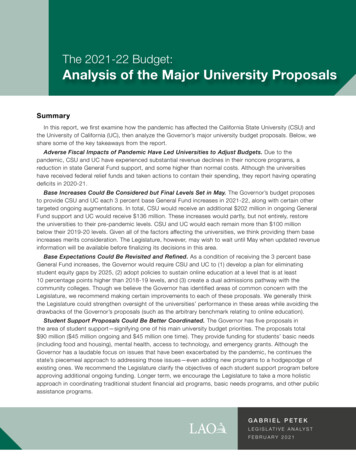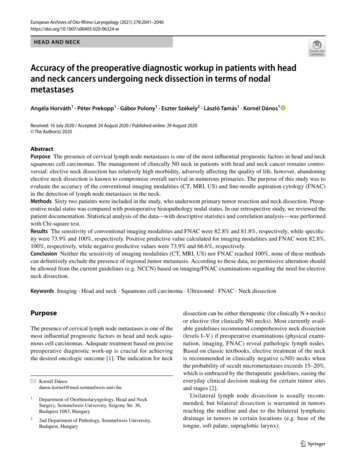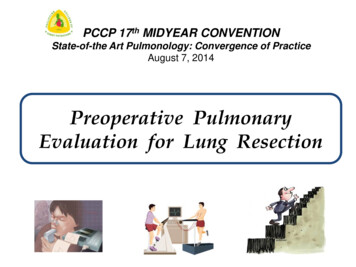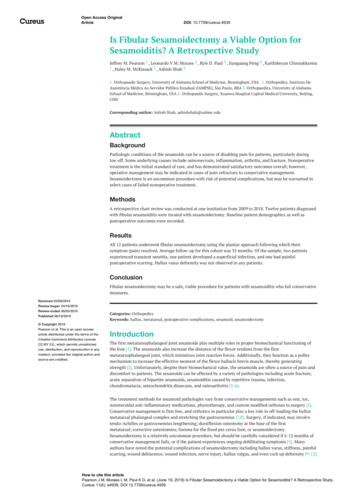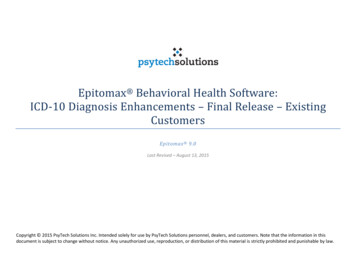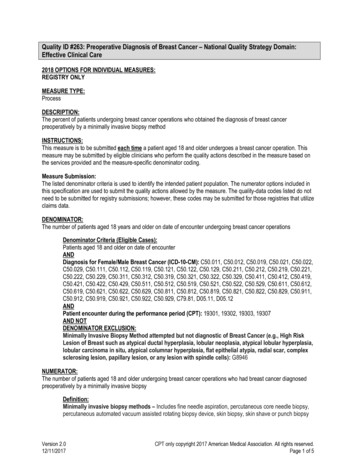
Transcription
Quality ID #263: Preoperative Diagnosis of Breast Cancer – National Quality Strategy Domain:Effective Clinical Care2018 OPTIONS FOR INDIVIDUAL MEASURES:REGISTRY ONLYMEASURE TYPE:ProcessDESCRIPTION:The percent of patients undergoing breast cancer operations who obtained the diagnosis of breast cancerpreoperatively by a minimally invasive biopsy methodINSTRUCTIONS:This measure is to be submitted each time a patient aged 18 and older undergoes a breast cancer operation. Thismeasure may be submitted by eligible clinicians who perform the quality actions described in the measure based onthe services provided and the measure-specific denominator coding.Measure Submission:The listed denominator criteria is used to identify the intended patient population. The numerator options included inthis specification are used to submit the quality actions allowed by the measure. The quality-data codes listed do notneed to be submitted for registry submissions; however, these codes may be submitted for those registries that utilizeclaims data.DENOMINATOR:The number of patients aged 18 years and older on date of encounter undergoing breast cancer operationsDenominator Criteria (Eligible Cases):Patients aged 18 and older on date of encounterANDDiagnosis for Female/Male Breast Cancer (ICD-10-CM): C50.011, C50.012, C50.019, C50.021, C50.022,C50.029, C50.111, C50.112, C50.119, C50.121, C50.122, C50.129, C50.211, C50.212, C50.219, C50.221,C50.222, C50.229, C50.311, C50.312, C50.319, C50.321, C50.322, C50.329, C50.411, C50.412, C50.419,C50.421, C50.422, C50.429, C50.511, C50.512, C50.519, C50.521, C50.522, C50.529, C50.611, C50.612,C50.619, C50.621, C50.622, C50.629, C50.811, C50.812, C50.819, C50.821, C50.822, C50.829, C50.911,C50.912, C50.919, C50.921, C50.922, C50.929, C79.81, D05.11, D05.12ANDPatient encounter during the performance period (CPT): 19301, 19302, 19303, 19307AND NOTDENOMINATOR EXCLUSION:Minimally Invasive Biopsy Method attempted but not diagnostic of Breast Cancer (e.g., High RiskLesion of Breast such as atypical ductal hyperplasia, lobular neoplasia, atypical lobular hyperplasia,lobular carcinoma in situ, atypical columnar hyperplasia, flat epithelial atypia, radial scar, complexsclerosing lesion, papillary lesion, or any lesion with spindle cells): G8946NUMERATOR:The number of patients aged 18 and older undergoing breast cancer operations who had breast cancer diagnosedpreoperatively by a minimally invasive biopsyDefinition:Minimally invasive biopsy methods – Includes fine needle aspiration, percutaneous core needle biopsy,percutaneous automated vacuum assisted rotating biopsy device, skin biopsy, skin shave or punch biopsyVersion 2.012/11/2017CPT only copyright 2017 American Medical Association. All rights reserved.Page 1 of 5
Numerator Options:Performance Met:ORORClinician diagnosed breast cancer preoperatively by aminimally invasive biopsy method (G8875)Denominator Exception:Documentation of reason(s) for not performing minimallyinvasive biopsy to diagnose breast cancer preoperatively(e.g., lesion too close to skin, implant, chest wall, etc.,lesion could not be adequately visualized for needlebiopsy, patient condition prevents needle biopsy [weight,breast thickness, etc.], duct excision without imagingabnormality, prophylactic mastectomy, reductionmammoplasty, excisional biopsy performed by anotherphysician) (G8876)Performance Not Met:Clinician did not attempt to achieve the diagnosis ofbreast cancer preoperatively by a minimally invasivebiopsy method, reason not given (G8877)RATIONALE:The preoperative diagnosis of breast cancer by minimally invasive methods is recommended by the American Societyof Breast Surgeons, the National Comprehensive Cancer Network, the European Society of Breast Cancer Specialists,the American College of Radiology, a recent consensus conference on image detected breast cancer, and a panel ofexperts who conducted a comparative effectiveness study of needle biopsy compared to open biopsy that was fundedby Agency for Healthcare Research and Quality (AHRQ).The policy of attempting to diagnose breast cancer by needle techniques has also been incorporated into qualitymeasurement programs developed by the American Society of Breast Surgeons and the National Consortium ofBreast Centers. (The American Society of Breast Surgeons, 2006)The advantages of preoperative cancer diagnosis by minimally invasive method include the patient centered measuresof a smaller scar, good cosmesis, timeliness, and good pain control. Other advantages include a greater likelihood ofachieving negative lumpectomy surgical margins and allowing concurrent scheduling of axillary lymph node surgery,reducing the number of operations required to treat breast cancer.CLINICAL RECOMMENDATION STATEMENTS:A major goal of modern breast medicine is to minimize the number of patients with benign lesions who undergo opensurgical breast biopsies for diagnosis. Image guided percutaneous needle biopsy is the diagnostic procedure of choicefor image-detected breast abnormalities. Patients with a clearly palpable breast mass should also have a minimallyinvasive percutaneous biopsy with or without image guidance depending on the size of the mass. (The AmericanSociety of Breast Surgeons, 2006) It is not possible to achieve a 100% success rate for the diagnosis of breast cancerby a minimally invasive technique due to some technical issues described above or sampling issues with high risklesions of the breast.COPYRIGHT:This measure is owned by The American Society of Breast Surgeons.THESE MEASURES AND SPECIFICATIONS ARE PROVIDED "AS IS" WITHOUT WARRANTY OF ANY KIND.Version 2.012/11/2017CPT only copyright 2017 American Medical Association. All rights reserved.Page 2 of 5
Version 2.012/11/2017CPT only copyright 2017 American Medical Association. All rights reserved.Page 3 of 5
2018 Registry Flow for Quality ID#263: Preoperative Diagnosis of Breast CancerPlease refer to the specific section of the Measure Specification to identify the denominator and numerator informationfor use in submitting this Individual Specification. This flow is for registry data submission.1. Start with Denominator2. Check Patient Age:a. If the Age is greater than or equal 18 years of age on Date of Service and equals No during themeasurement period, do not include in Eligible Patient Population. Stop Processing.b. If the Age is greater than or equal to 18 years of age on Date of Service and equals Yes during themeasurement period, proceed to check Patient Diagnosis.3. Check Patient Diagnosis:a. If Diagnosis of Male/Female Breast Cancer as Listed in Denominator equals No, do not include in EligiblePatient Population. Stop Processing.b. If Diagnosis of Male/Female Breast Cancer as Listed in Denominator equals Yes, proceed to checkEncounter Performed.4. Check Encounter Performed:a. If Encounter as Listed in the Denominator equals No, do not include in Eligible Patient Population. StopProcessing.b. If Encounter as Listed in the Denominator equals Yes, proceed to Denominator Exclusion.5. Check Denominator Exclusion:a. If Denominator Exclusion as listed equals Yes, do not include in Eligible Denominator Patient Population.Stop Processing.b. If Denominator Exclusion as listed equals No, proceed to Eligible Population.6. Denominator Population:a. Denominator Population is all Eligible Patients in the denominator. Denominator is represented asDenominator in the Sample Calculation listed at the end of this document. Letter d equals 80 procedures inthe Sample Calculation.7. Start Numerator8. Check Breast Cancer Preoperatively Diagnosed by a Minimally Invasive Biopsy Method:a. If Breast Cancer Preoperatively Diagnosed by a Minimally Invasive Biopsy Method equals Yes, include inData Completeness Met and Performance Met.b. Data Completeness Met and Performance Met letter is represented in the Data Completeness andPerformance Rate in the Sample Calculation listed at the end of this document. Letter a equals 40procedures in the Sample Calculation.Version 2.012/11/2017CPT only copyright 2017 American Medical Association. All rights reserved.Page 4 of 5
c. If Breast Cancer Preoperatively Diagnosed by a Minimally Invasive Biopsy Method equals No, proceed toDocumentation of Reason(s) for Not Performing Minimally Invasive Biopsy to Diagnose Breast CancerPreoperatively.9. Check Documentation of Reason(s) for Not Performing Minimally Invasive Biopsy to Diagnose Breast CancerPreoperatively:a. If Documentation of Reason(s) for Not Performing Minimally Invasive Biopsy to Diagnose Breast CancerPreoperatively equals Yes, include in Data Completeness Met and Denominator Exception.b. Data Completeness Met and Denominator Exception letter is represented in the Data Completeness andPerformance Rate in the Sample Calculation listed at the end of this document. Letter b equals 10procedures in the Sample Calculation.c. If Documentation of Reason(s) for Not Performing Minimally Invasive Biopsy to Diagnose Breast CancerPreoperatively equals No, proceed to Clinician did Not Attempt to Achieve the Diagnosis of Breast CancerPreoperatively by a Minimally Invasive Biopsy Method, Reason Not Given.10. Check Clinician Did Not Attempt to Achieve the Diagnosis of Breast Cancer Preoperatively by a MinimallyInvasive Biopsy Method, Reason Not Given:a. If Clinician Did Not Attempt to Achieve the Diagnosis of Breast Cancer Preoperatively by a MinimallyInvasive Biopsy Method, Reason Not Given equals Yes, include in the Data Completeness Met andPerformance Not Met.b. Data Completeness Met and Performance Not Met letter is represented in the Data Completeness in theSample Calculation listed at the end of this document. Letter c equals 20 procedures in the SampleCalculation.c. If Clinician Did Not Attempt to Achieve the Diagnosis of Breast Cancer Preoperatively by a MinimallyInvasive Biopsy Method, Reason Not Given equals No, proceed to Data Completeness Not Met11. Check Data Completeness Not Met:a. Data Completeness Not Met equals No, Quality Data Code or equivalent not submitted. 10 procedures havebeen subtracted from Data Completeness Numerator in the Sample Calculation.Version 2.012/11/2017CPT only copyright 2017 American Medical Association. All rights reserved.Page 5 of 5
The policy of attempting to diagnose breast cancer by needle techniques has also been incorporated into quality measurement programs developed by the American Society of Breast Surgeons and the National Consortium of Breast Centers. (The American Society of Breast Surgeons, 2006)
